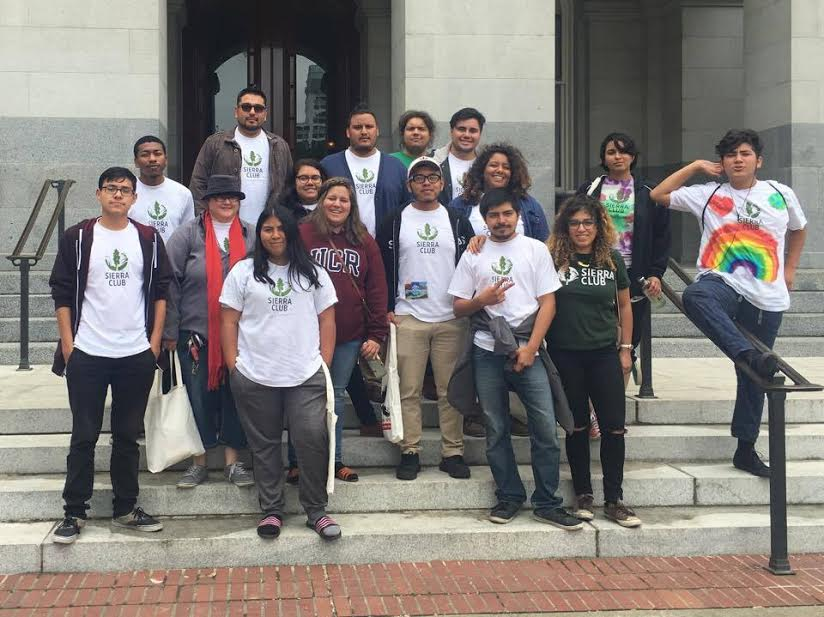In late April, the Trump administration issued its executive order reviewing national 26 monuments, turning federal lands across the country into flashpoints for conflict. Trump’s order represents energy interests that wouldn’t hesitate to start logging, drilling, fracking, or mining in these treasured lands. Those who see it as our duty to preserve them are mobilizing, and rallies are springing up from California to Massachusetts, with and without Sierra Club backing.
It’s up to Trump’s Secretary of the Interior, Ryan Zinke, to make the call, on a case-by-case basis, whether to let the monuments be, shrink them, or abolish them entirely. As he’s toured the monuments and nearby communities gathering feedback, he’s been relentlessly followed— or “bird-dogged”—by protesters want to see our national monuments left intact.
When Zinke visited Hooksett, New Hampshire, on June 13, ten members of the Sierra Club’s New Hampshire Chapter were standing outside the Bass ProShop where Zinke spoke, sending him a message: keep our federal lands protected and accessible to all. Three days later in Boston, a crowd of protesters gathered at the Massachusetts statehouse advocating for both Bears Ears and the close-by Northeast Canyons and Seamounts Marine National Monument. When he returned to Washington, D.C., on June 20 for a hearing on the Department of the Interior’s proposed budget, three Sierra Club interns wearing “PROTECT BEARS EARS” shirts had taken front row seats, making a silent protest in front of the C-SPAN cameras. Zinke later personally assured them that they would be pleased with how the budget turned out.
But the protests haven’t been only in Zinke’s wake. In California, the lands in jeopardy include the Mojave Trails, Sand to Snow, and San Gabriel Mountains National Monuments. The city of Santa Clarita has released a comment letter signed by all five of their council members, firmly telling Zinke to keep their nearby San Gabriel National Monument as it is. On June 8, a group of exhausted and enthusiastic young activists from California communities spent the day in Sacramento making their voices be heard at the state capitol by lobbying for protection of the monuments. Youth in San Bernardino and East Coachella Valley have collected signatures and attended community hearings in support of Mojave Trails.
Bears Ears National Monument in Utah has been prominent in this fight. It’s attracted considerably more attention and conflict than the rest of the monuments, as a contingent of local interests is opposed to the monument. In fact, the entire Utah congressional delegation, governor, and state legislature oppose the monument. In an interview with The Revelator, Navajo Nation spokesman Davis Filfred said of the anti-monument interests, “They want to go after coal. They want to go after petroleum, uranium, potash. They want to clear all the timber.”
Zinke toured the monument with Utah governor Gary Herbert and members of the San Juan County Commission, who all oppose the monument. He also met twice with The Bears Ears Inter-Tribal Coalition, which is fighting to preserve the monument in full as it contains ancient pottery, artifacts, and sacred sites. The original intent of the Antiquities Act of 1906, under which Bears Ears was created, was in part to protect land significant to Native Americans, who continue to live off the land’s natural resources as they have for centuries. If Zinke were to abolish or diminish Bears Ears, it would be yet another broken government promise to the tribes.
Zinke professes to understand the importance of federal lands.“Over the course of our history, I think it’s undisputed that the monuments have been an effective tool to save [and] preserve some of our greatest cultural treasures,” he said at an April news conference in Utah. He has called Bears Ears “drop-dead gorgeous” and taken to imitating conservationist president Teddy Roosevelt, trotting to his first day of work in washington on horseback. He even tweeted a photo of himself with a park ranger as an homage to a classic photo of Roosevelt and John Muir.
Despite appearances, he had no qualms about lifting an Obama-era moratorium on coal mining on federal lands, signing an order repealing it in March—he’s championed an “all of the above” energy strategy. On climate change, he’s waffled. He said at one point in a January hearing that “there’s a debate” on whether it’s human-caused, but at one point in the same hearing admitted that humans have “an influence” on the climate. He also testified under oath that there is no scientific consensus on whether climate change is caused by humans, a notion contradicted by 97% of climate scientists. Zinke talks the talk, but if he doesn’t see any problem with opening up federal lands to mining and he questions climate science, does he really have the protection of America’s wilderness at heart?
Wherever he’s gone, Zinke’s been met with reminders of Americans’ desire to keep our federal lands intact. People on both sides of the conflict claim that the most treasured parts of the monuments will be preserved—no one wants to hear that Bears Ears or another precious landscape will be lost. The protests springing up in the wake of Zinke’s tour and around the country show that Americans care deeply about their national landscape. Ryan Zinke and the rest of our government owe us its protection.
